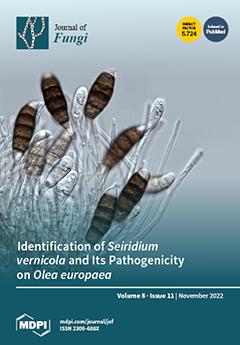The
Metarhizium fungal species are considered the prolific producers of bioactive secondary metabolites with a variety of chemical structures. In this study, the biosynthetic potential of marine-derived fungus
Metarhizium sp. P2100 to produce bioactive alkaloids was explored by using the one strain many compounds (OSMAC) strategy. From the rice solid medium (mixed with glucose peptone and yeast broth (GPY)), wheat solid medium (mixed with Czapek) and GPY liquid medium, one rare
N-butenone spiroquinazoline alkaloid,
N-butenonelapatin A (
1), together with nine known compounds (
2–
10), were isolated and identified. Their structures were elucidated by analysis of the comprehensive spectroscopic data, including 1D and 2D NMR and HRESIMS, and the absolute configuration of
1 was determined by a single-crystal X-ray crystallographic experiment.
N-butenonelapatin A (
1) represents the first example of
N-butenone spiroquinazoline with a rare
α,
β-unsaturated ketone side chain in the family of spiroquinazoline alkaloids. Compound
4 displayed antibacterial activity against
Vibrio vulnificus MCCC E1758 with a minimum inhibitory concentration (MIC) value of 6.25 µg/mL. Compound
7 exhibited antibacterial activities against three aquatic pathogenic bacteria, including
V. vulnificus MCCC E1758,
V. rotiferianus MCCC E385 and
V. campbellii MCCC E333 with the MIC values of 12.5, 12.5 and 6.25 μg/mL, respectively. Compounds
3 and
6 demonstrated anti-inflammatory activity against NO production induced by lipopolysaccharide (LPS) with the IC
50 values of 37.08 and 37.48 μM, respectively. In addition, compound
1 showed weak inhibitory activity against the proliferation of tumor cell lines A-375 and HCT 116. These findings further demonstrated that fungi of the
Metarhizium species harbor great potentials in the synthesis of a variety of bioactive alkaloids.
Full article






